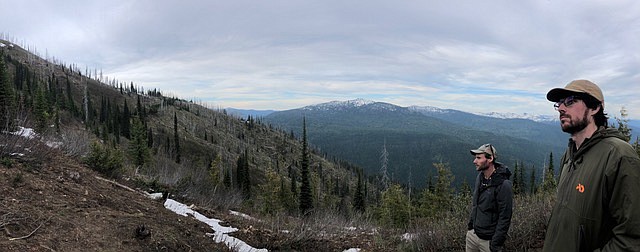U of I pair’s caribou project seeks border country stories
Gray ghosts, high mountain deer, forest caribou, the woodland caribou of the Selkirk Mountains went by many names and their ancestors once ranged from coast to coast across the North American midsection along the border country between Canada and the U.S.
The floundering of the ancient species and its extirpation — the remaining three caribou were last year relegated to a small group at a Canadian breeding facility — prompted two University of Idaho students to undergo a project to keep the animals alive, at least in stories.
Graduate students Chris Lamb and Jack Kredell are collecting oral histories from Idahoans who encountered the animals in the wild, people who followed the almost 40-year effort to restore them to the northern Panhandle, and those who were heartened by their existence, or who accept their passing.
Kredell, who grew up in Pennsylvania, said he was drawn to caribou because of their uniqueness.
“They were the lower 48 relic of the Ice Age,” Kredell said. “The world left them behind.”
Lamb was brought to the project by Kredell and the two opted to pursue a broad extrapolation that used local history — gathered in large part from the men and women who lived near or among the animals — into a digital archive.
“We’re imagining it as a community response to the extinction of the caribou,” Lamb said. “The ecological community and human community, considered together.”
Neither Kredell nor Lamb are scientists. Kredell earned a degree in English and environmental studies while Lamb, who is from New England, also studied English as an undergraduate. The project, the men said, is to some extent literary. It combines science with the humanities and mixes investigative work, and a variety of other disciplines. The final project will parallel the work of other naturalists including Aldo Leopold — the author of “A Sand County Almanac,” and Barry Lopez who wrote “Of Wolves and Men,” and “Arctic Dreams.”
“A major scope of the project is oral history,” Lamb said.
To collect stories the men have posted ads in local newspapers and sought contacts from across Idaho’s northern tier.
“We’ve put out announcements and calls for stories in various papers around North Idaho and we’re asking people to reach out to us via email,” Lamb said. “We’re going to conduct interviews over the phone, or in person ... we would prefer to do them in person.”
The project will use a multi-layered map comprised of stories, landscape, geographical and ecological layers to document the caribou’s existence in North Idaho and southern Canada in the Purcell and Selkirk mountains, and the population’s stagger and collapse.
In 2017, biologists counted 11 caribou in the local Selkirk population and 16 on the Purcell side. Both populations in the 1950s numbered more than 100 animals. By 2018, the population had dwindled further with the three cows in the Selkirks that spent more time on the Idaho side of the international border with Canada than the neighboring Purcell herd, which was comprised of three bulls and one cow.
The oral histories don’t need to revolve around first-hand wildlife experiences, the men said.
“It doesn’t have to be a physical encounter,” Kredell said. “Maybe a thought or opinion about the loss of caribou in North Idaho or about any member of northern Idaho’s ecology, such as wolves for example.”
The men expect a cross section of voices from the believers that the animals disappeared because of logging and climate change, and others who think a surge in wolf, grizzly and mountain lion populations ended the species that seemed to be unable to adapt to a changing landscape.
“We want to include all voices and opinions on the topics,” Kredell said.
Anyone who wants to take part should write to clamb@uidaho.edu.



